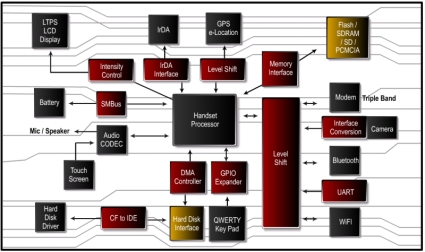Demo platform promotes use of PLDs in “smart handsets”
Jan 4, 2006 — by LinuxDevices Staff — from the LinuxDevices Archive — 3 views Xilinx has released a demonstration platform that aims to show the benefits of programmable devices for accelerating the development of “smart handsets.” The Handset Demonstration Platform supports Linux, and uses the company's CoolRunner CPLD family of devices to implement new handset features and co-processing… functionality.
Xilinx has released a demonstration platform that aims to show the benefits of programmable devices for accelerating the development of “smart handsets.” The Handset Demonstration Platform supports Linux, and uses the company's CoolRunner CPLD family of devices to implement new handset features and co-processing… functionality.
The demo platform consists of a board-level computer based on an Intel PXA 270 XScale processor, and equipped with SDRAM, Ethernet, a USB port, and a means to add external flash memory. The platform runs either Linux or Windows CE, and includes positions for four CoolRunner-II daughter cards (shown in the above photo) that can be used to add functions such as keyboard scanning, high resolution displays, and embedded hard disk drives.
Xilinx says its platform demonstrates that CPLDs (complex programmable logic devices) can provide co-processing functions to accelerate the introduction of advanced handset features faster than existing design approaches, while meeting stringent power consumption, size, and cost constraints.
Xilinx offers application notes on using CPLDs in conjunction with most of the functions shown in the above “Smart Mobile Handset” block diagram
(Click image to enlarge)
David Loftus, GM of Xilinx's CPLD division, stated, “This initial demonstration board underscores our commitment to making programmable solutions accessible and easy-to-use, giving developers an excellent tool for quickly bringing new products to market.”
The Handset Demonstration Platform will be on display at this week's Consumer Electronics Show (CES) in Las Vegas.
This article was originally published on LinuxDevices.com and has been donated to the open source community by QuinStreet Inc. Please visit LinuxToday.com for up-to-date news and articles about Linux and open source.
